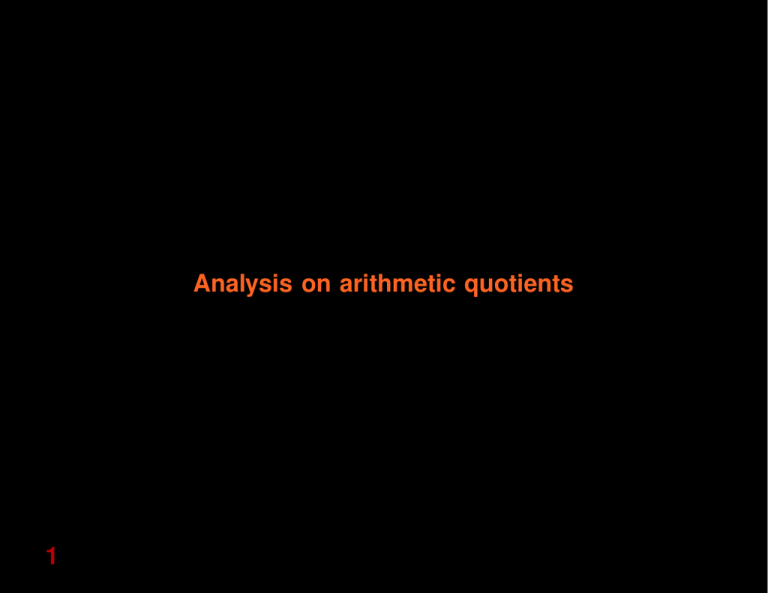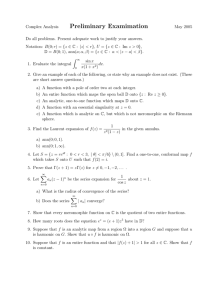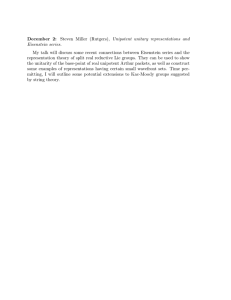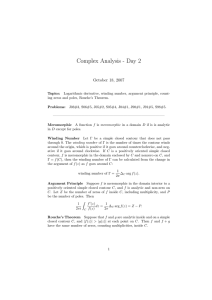Analysis on arithmetic quotients 1
advertisement

Analysis on arithmetic quotients
1
This talk will be found at
http://www.math.ubc.ca/˜cass/sydney/talk2.pdf
2
Let
be the group of real points on a reductive
group defined over , a group of finite index in
. The spectrum of
is of great numbertheoretical interest.
In this talk I’ll try to give some idea of some of the
difficulties involved in the subject, by explaining
. This talk will
something of what happens for
be largely a talk in analysis, since it is the analysis
involved that most people find intimidating. I’ll say
almost nothing of the connections with number theory.
3
Geometry
4
5
mod
$
"#
%
!
'
&
*
)
(
)
(
'
&
)
(
'
&
-
,
-.
,
+
*
'
&
'
&
1
2
0
/
)
(
)
(
+ .
,
,
/
3
)
!
( !
6
8
7
654
9 7
:
;
<
9 7
;
7
5
=
8
5
=
=
@
A
654
>
?
=
@
4
B
7
.
is the stabilizer of
The group
D
For in , and generate a lattice in . An eletakes this to the lattice spanned by
ment in
and
, which span the same lattice. This
is similar to the lattice spanned by
and .
C
C
K
JI
H
GF
E
C
O
C
L
MN
MP
C
O
C
L
MN
MP
K
I
KQ
I
D
S
8
R
In fact, points of the quotient
larity classes of lattices in .
parametrize simi-
T
The fundamental domain of
is the region
U
Vc
ba`
[ `
_
XW
V
^]\
[Z
Y
XW
V
[
There is a simple reduction algorithm transforming
an arbitrary to one in this region, a succession of
transformations
U
Uf
de
g
h
[
[
U
Uf
V
g
[ W
[
ei
j
The algorithm stops because in every cycle increases. It is also related to the problem of finding
a relatively orthogonal basis for lattices.
9
Γ ∩ P \HY ,→ Γ\H (Y ≥ 1)
y=Y
10
wxrm
v
t
has height
u
srq
n
m
po
l
k
11
: the image of
.
The problem
12
{ y
{ y~
}
|
{ yz
{
{
{
{
}
{
{ ~
y
y~
}
y
{
13
is essentially self-adjoint
The differential operator
.
on
What is its spectrum?
This is a special case of another question. Funcmay be identified with functions on
tions on
fixed on the right by . The operator
is the
of the Casimir element of
,
restriction to
.
which lies in the centre
What is the decomposition of
into eigenspaces
of , or (equivalently) irreducible unitary representations of ?
14
The first step is to make a simple decomposition.
is invariant under
Any reasonable -invarant on
integral horizontal translations, so
|
x
The function is called cuspidal if the constant term
vanishes. With mild conditions on , the differvanishes very rapidly at . The subspace
ence
ª
©§¨
¥¦¤
¡¢£
decomposes into finite-dimensional eigenspaces of
(looks like
of a compact Riemannian manifold).
15
¬ «
­
º
²
º
¹¯
³¸µ
·¶´µ
´°
¾
¬ «
­
·¶´µ
´°
±³²
¿À
¬ «
­
±³²
¬ «
­
®
±¯°
®
¬ «
­
¶
½¸¼
³»
´µ
¯
±¯°
All three of these components are related to number
theory.
È
ÇÆ
¿
 Å
Ä
 Á
Ã
¬ «
The spectrum of
is
, and we
can describe the eigenfunctions contributing to it
rather explicitly.
´µ
´°
±³²
±¯°
¬ «
is a mystery. The few
The decomposition of
constituents explicitly known are related to representations of Galois groups.
½¸¼
³»
´µ
¯
16
are linked to-
Ê É
Í
Î
Õ
ÓÕ
ÔÒ
ÔÏÓ
and
ÊËÉ
The spaces
gether.
Ñ
ÑÒ
ÐÎÏ
ÍÌ
The continuous spectrum directly involves
ß
ÝÞØ
Ü×
Û
â
Ù
Êã ä
à
Ù
Ø
Ü×
Û
Ú
ß
Ø
Ù
Ø×
Ö
å
ë
has a simple pole at
is its residue there.
Ü æ
ß
Ø×
Ú Ù
ß
Ú ì
Ù
Ø×
Ö ì
We have
on
tion of the eigenvalues on
on that line.
winding of
Ê É
ïÌî
ͦí
Î
Õ
Ï
Ù
Ø×
Ö
17
éêè
Ù
Ø×
çÙ
Ø×
á
Ü æ
å
Ú Ù
Ø×
Û
Ú Ù
x
Ø×
Ö
The function
volume of
and the
and the distribuis related to the
õ
ôó
ò
ñð
The principal tool is the trace formula, which still
.
holds many secrets, even for
At any rate, understanding it requires understanding the continuous spectrum, which is spanned by
Eisenstein series.
18
Eisenstein series
19
invari-
ø
For in
the function
is a function on
and indeed
.
ant with respect to
ö
÷
ûú
ù
ø
ø
ÿ
Þþö
ü
ö
÷
÷
ý
The Eisenstein series is
ø
ü
÷
ý
ý
ø
÷
þÞö
ø
ÿ
ö
þ ö
ü
ý
ý
ü
ÿ
ö
ø
ý
20
ø
. Since
ÿ
ö
converges for
For
since
!
"
"
!
!
this is also
3
2
6
3
!
"
4
5 4
1
,
0 /
.-'
#
&%$
)+*'(
#
These series were first investigated by Maass, after some hints by Hecke. The hard theorems about
them were first proven by Selberg.
21
8
9 8
:
7
;
8
;
<
8
N J
O
M
<
KL J
G
IH
AC
F E
D.C
AB@
*>?=
22
X
ZY
\
_
_`
]^\
R
U
WVP
S R
T
Q P
a \
b
[
edX
]
c
c
m
lk
j i
g f
h
U
n
23
srq
po
The Laplacian is negative, which means that its spec. This corresponds to
trum is contained in
with
as well as
Eisenstein series
on the line segment
.
t
{
Terra Incognita
t
<(s) = 1/2
q
r ~
24
s=1
w
} |
{
wo
v
y x
z
u
Here
lieth
zeros
Convergence
Theorem. The function
continues meromorphically into all of . It satisfies the functional equation
e
Near
e
W
In
it has exactly one pole, which is
a simple pole with residue the constant function
.
A consequence is that
25
The Plancherel theorem
26
is a continuous function of compact support
, define the integral
If
on
®
¢
z
¬­¦
¡
£
ǻ
©
¨ §
B¦¥
¤
Then
«
«
¢
®
¯
¯
¯
¯
induces an isometry (up to a con-
The map
stant factor)
±°
«
¹
¸
µ
Â
Á
¿À
¿»
¼¾½
¼º»
.
¢
·¶
´
s³
²
´
27
«
with
The principal theorem is the decomposition
Ä Ã
Ä Ð
Ä Ã
Æ
Ä Ã
Å
Î
×
ÕÓÔ
ËÖ
ÌÍ
Ç
Ó
Ò
ÕÌÔ
Ë
ÑÍ
28
ÏÎÌÍ
ÌÈ
ÉËÊ
ÉÇÈ
along with variants.
Ü
Ø
ê
ì­â
ê
ìâ
eîå
Ø
ä ã
Bâá
à
Ø
ᕆ
ᕆ
ê
­ìâ
ê
è
ë
é
é
í ë
çæ
å
Ü
ë
Þß
ê
Ý
Ú
êé
è
íë
è
ä ã
Bâá
à
ë
çæ
å
Ü
êé
Þß
êé
Ý
Ú
Ý
Þß
çæ
å
ä ã
Bâá
à
Ú
Ø
Ù
ð
ï Ü
ï·Ü
ê
ê è
í
ë
é
ë
é
óòë
ê é
è
Ý
ê
ë
é
è
Ú ë
ï Ü
Ú ë
ê é
ñ
êè é
ë
ê é
è
í
ñ
ñ
29
Û
Ú Ù
Ø
where
ô
In the rest of this talk, I’ll try to give some idea of
how the proof of meromorphic continuation of
goes.
õ
30
The constant term
31
ú û
Any function
on
is invariant under
,
and may therefore be expressed in a Fourier series
÷
÷
ö
ü
ù
ø
û
ö
ö
ý
ÿ
þý
û
ö
ö
þ
ý
ÿ
þ ý
ö
ö
ý
32
is called the constant term of
If
satisfies a certain mild growth condition on the
, then
is
fundamental domain as
.
rapidly decreasing as
The constant term controls the asymptotic behaviour
of .
The cuspidal component of
is that of functions
whose constant term vanishes, and cuspidal functions are of rapid decrease at . The cuspidal comof a compact Riemannian surponent looks like
face.
33
Since
and
is the constant term of
!
"
!
#
commutes with
then
, if
"'
%% "
&
$
#
!
This has solutions
*
)
#
!
, +
-
(
#
#
Since we already know that
for
of
is the dominant term
/.!
*
)
01
#!
#
#
!
"
*
)
01
0
#!
#
, +
-
./!
#
is square integrable if
34
rapidly decreasing stuff
Analytic continuation
by spectral analysis of the Laplacian
35
4
2
Fix
. Let
be a
smooth function identically
for large and for
.
3
8
76
5
4
2
y −→
9
:
7
7
5
The function may be identi. If
is
fied with one on
satisfying
any function on
a mild growth condition then
will be rapidly
decreasing at .
=
;
<
;
<
=
F
D 5
E
CB=
A@=
>
?
G
36
J
For in the region of convergence,
. If
then
in
O
NEM
KLJ
I
H
will be
V
K H
H
TSR
QP
W
U
J
K
R
R
O
N M
I
K J
K
U
W
U
W
U
U
W
W
J S
O
N M
I W
R
K J
K
U
J
K
K
R
O
N M
S
W
U
W
U
X
a function of compact support on
, defined for
all . Since is not in the spectrum of the self adis a bounded operator on
joint operator ,
, and
will be the unique function in
satisfying this equation. This allows us to
extend the definition to the whole region
except the segment
, since this region is in
the complement of the spectrum.
Y
R
H
Z
[
K
R
W
U
J
O
N M
K J
I
X
\
Q P
W
W
Y
X
Y
U
Q P
U
/]W
U
_ ^
-
V
H
V
`
a
U
_-^
V
37
Setting
i
j
k
will define
throughout this region
compatibly with
its definition by
the series.
b
c
Terra Incognita
n
m l
n
e
h
e
h
pqo
h
c
m l
E
b
g
g
e
s=1
c
c
f
f
f
d c
b
38
Spectral
complement
Meromorphic continuation
by Fredholm theory and Hecke operators
39
r
A compactly supported function on
that’s invariant under non-Euclidean rotation lifts to a function
that’s left and right invariant with respect to
on
is a function on
then
multiplication by . If
t
s
u
s
Aws
{
y
|
} |
{
r
{
z y
v
x
t
is again a function on
. Convolution makes
the set of all such functions into a ring
(that’s
for
).
u
|
~
u
y
40
Geometrically speaking, this operator replaces the
at a point by a weighted integral of its
value of
average values on non-Euclidean circles concentric
at . The functions are what Selberg called pointpair invariants.
If is the characteristic function of the unit disc
replaces
at any point
around , the operator
by the average value of
over the unit disc centred
at .
41
The operator
commutes with the actions of
and its Lie algebra on . The function
is, up to
scalar, unique with the two properties
42
Therefore there exists a homomorphism
to
such that
from
Define a truncated form of
:
This is a compact operator, hence by the Fredholm
theory its resolvent
¢
£
¡
¡
¤
¤
¦
¥
is meromorphic. If
convergence
then in the region of
§¤
¡
¤
¤
¤
§
§-
¤
¡
¢£
¤
¤
«
©ª
¬
¨
¢£
¤
¤
©ª
¤
¬
¨
«
¡
43
½
¼
²
²
¯
¹º
²
·³
¾
·¸
³
·­
¶
²
¯
±
²
·³
·­
¶
´ ³
²
±
¿ µ ²
¯
­
®
then we could set
»­
±
µ ²
´-³
²
±
¿
¿
²
À ²
Á
½
¹º
»­
¼
´-³
´
µ ²
´
44
¯°®
­
If we could solve
To solve
Æ
Ä
Å
Æ
Í
ÌÇ
ÌÂ
Ë
É L
Ê Æ
È-Ç
Æ
Å
Ä°Ã
Â
Æ
ÉÄ
È
È
Ï Î
Ð
É Ê
É
we want to rewrite it as an equation with something
on the right hand side. Set
,
in
which gives
ÌÇ
Æ
Å
Æ
Ë
Ç
Æ
Ã
Ã
Ã
Æ
Ê
ÌÇ
ÌÂ
ÌÇ
Ã
ÌÂ
Ë
Æ
ÆÄ
Ê
ÌÇ
ÌÂ
Ë
Ë
Ë
Ã
Ã
45
ÌÇ
ÌÂ
ÌÂ
Ä
Â
Â
Ë
Æ
Æ
È-Ç
Æ
Å
È-Ç
Æ
Å
É Ñ
Ä Æ
Ä
É Ê
É
Ä
Â
and this right hand side has compact support.
Ó
Ô
Ó Ò
We can find
as a meromorphic function of
throughout , then find
, and finally set
Ö
Õ
Õ
Ò
Ó Ò
Ó Ò
Ö
Ú
× Õ
Ò
ßÞÝ
Ü
Û
ÙØÕ
Õà
Ö
Ú
if we can somehow find the meromorphic continua. But
tion of
Ü
Û
ã
ä
Õ
× Õ
Ò
â á
°
Ü
Û
which means that
Ó Ò
ã
Ö
Ú
ßÞÝ
Õ
Ü
Û
Ü
Û
Ü
Õ
â á
°
â
Õ
Ö
Ú
Ü
Û
46
× Õ
Ó Ò
ã
â á
°
Û
so we can define
as the ratio of the two sides.
Summary:
ê é
-
è
/ïî
ì
íç
è ë
ê é
-
æ
è ç
-
å
Spectral analysis of
allows us to analytically conto all but
in
. It also
tinue
allows us to get growth estimates, since there is a
.
classical bound on
ó
ô
ñ
ò
ð
ð
For meromorphic continuation we use Hecke operators.
ñ
î
è ç
ö
æ
, hence
.
íç
ö
óô
å
ê é
-
è
í ç
õ
è
í
å
ø
æ
ù
47
õ î
è
í ç
ö ÷
õ î÷
è
õ î
í
The simplicity of the pole at
.
explicit formula for
î
íç
ö
õ æ
å
From the first, we get
. Also
on
follows from an
Completeness of the dis-
ú
ú
48
ú
The Plancherel formula
crete spectrum.
References
J. Bernstein, Meromorphic continuation of Eisenstein
series, notes based on lectures, undated but probably sometime around 1985. A more elaborate and
more general version of Selberg’s integral operator
proof.
ÿ-þ
ý
üû
A. Borel, Automorphic Forms on
, Cambridge
Tracts in Mathematics 130, 1997. Follows Bernstein.
Bill Casselman, On the Plancherel measure for the
continuous spectrum for the modular group, pages
49
19–26 in Automorphic forms, automorphic representations, and arithmeric, Proceedings of Symposia in Pure Math. 66, A. M. S., 1997. Calculates
the Plancherel measure without analytic continuation.
Bill Casselman, Harmonic analysis of the Schwa, to appear in the proceedings of a
trz space of
conference in honor of Joe Shalika.
Y. Colin de Verdière, Une nouvlle démonstration du
prolongement méromorphe des séries dEisenstein,
C. R. Acad. Sci. Paris 293 (1981), pages 361–363. The
simplest version of continuation by spectral analysis
of .
50
I. Y. Efrat, The Selberg Trace formula for
,
Memoirs of the American Mathematical Society 359,
1987. The simplest published form of Selberg’s proof
of meromorphic continuation.
E. Hecke, Eisensteinreihen höhere Stufe und ihre
Anwendungen auf Funktionentheorie uns Arithmetic,
Abh. Math. Sem. Hamburg, 5 (1927), 199-224. First
mention of non-holomorphic automorphic forms.
pendix F contains a proof of Selberg’s from which the
proof given in Efrat’s book is derived.
51
,
D. A. Hejhal, The Selberg Trace Formula for
Lecture Notes in Math. 1001, Springer, 1983. Ap-
T. Kubota, Elementary Theory of Eisenstein Series,
Wiley, 1973. Mostly follows Selberg.
R. P. Langlands, Eisenstein series, pages 235–252
in Algebraic Groups and Discontinuous Subgroups,
Proceedings of Symposia in Pure Mathematics IX,
A. M. S., 1966. Has his own proof od meromorphic
continuation, aong with a sketch of what happens in
higher rank. He also proves the Plancherel formula
here, by analytic continuation.
H. Maass, Über eine neue Art von nichtanalytischen
automorphen Funktionen und die Bestimmung Dirichletscher Reihen durch Funktionalgleichen, Math.
52
Ann. 121 (1949), pages 141–183. First mention of
the Eisenstein series
, whose meromorphic continuation is proven by using known properties of
applied term-by-term to its Fourier expansion.
W. Roelcke, Über die Wellengleichung bei Grenzkreisgruppen erster Art, Sitzbericht Heidelberg Akad.
Wiss., 1953–1955, 159–267. First attempt to use spec-
tral analysis to prove continuation.
W. Roelcke, Analytische Fortsetzung der Eisensteinreihen zu den parabolischen Spitzen von Grenzkreisgruppen erster Art, Math. Ann. 32 (1956), 121–129.
Carries the program further, but inconclusively.
53
A. Selberg, Discontinuous groups and harmonic
analysis, pages 177–189 in Proc. Int. Cong. Math.,
Stockholm, 1962. An announcement of the first complete proof of the meromorphic continuation relying
only on spectral methods. Also the first proof of the
spectral completeness of cusp forms and the residues
of the Eisenstein series.
A. Selberg, Introduction to the Göttingen lecture
notes, in the Collected Works. A personal account
of the subject.
54
![Mathematics 414 2003–04 Exercises 5 [Due Monday February 16th, 2004.]](http://s2.studylib.net/store/data/010415766_1-b65af2bb66ab8e422354912dcedcb6a6-300x300.png)
![Errata to [J]](http://s2.studylib.net/store/data/011097522_1-258cabb48868c75b64a32703d13215c2-300x300.png)






